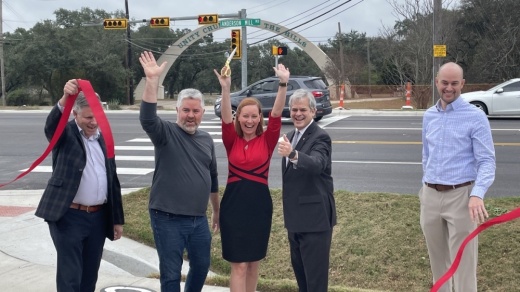Current and former Austin elected officials joined the transportation and public works departments for a ribbon cutting ceremony celebrating the completion of construction on Anderson Mill Road in Northwest Austin on Dec. 16.
Austin Mayor Steve Adler said when he was running for office in 2014, improvements to Anderson Mill Road were the one thing constituents in the area asked about most—a sentiment former District 6 Council Member Jimmy Flannigan echoed.
“I could not be happier to be standing here today to see this project come to fruition,” Flannigan said. “It was very clearly the most important thing that I was doing while I was a council member.”
City staff said the improvements to Anderson Mill Road, which span from US 183 to Spicewood Parkway, were designed to increase traffic flow and pedestrian safety.
District 6 Council Member Mackenzie Kelly said as a graduate of Westwood High School, which is located in the Anderson Mill neighborhood, she has seen firsthand how treacherous the road was prior to the improvements.
Among the enhancements to the road are a raised median near US 183 to reduce collisions at the intersection, shared-use paths on both sides of the road for pedestrians and bicyclists, a pedestrian hybrid beacon, and a new lane configuration at the intersection of Olson Drive.
Other upgrades to the roadway include water quality improvements in the form of rain gardens that minimize the effect of pollutants and the addition of 100 new trees to the corridor, said Eric Bailey, assistant director of public works.
Additionally, the city repaved Anderson Mill Road from US 183 to Spicewood Parkway beginning in late October and added a center left-turn lane along the entire stretch of road.
“Every person I spoke to in Anderson Mill, in Balcones Woods, in all of these neighborhoods around here say this is the greatest transportation project they have ever seen,” Flannigan said.
The city first broke ground on the project in the summer of 2020, and was able to complete construction one month ahead of the originally proposed timeline, Bailey said.
The $8 million project is the first regional mobility project to be designed and fully constructed from the 2016 $720 million voter-approved mobility bond. Adler said this bond allocated more money to transportation projects than the city had spent on mobility in the previous 20 years.
“Austin has never had so much mobility investments going on at the same time,” Transportation Director Robert Spillar said. “In the coming years, that will become the issue that we have to deal with is how do we manage all of those projects at the same time. What a great problem to have for a change.”





